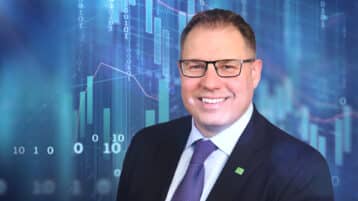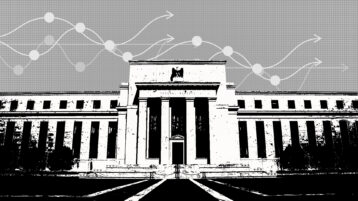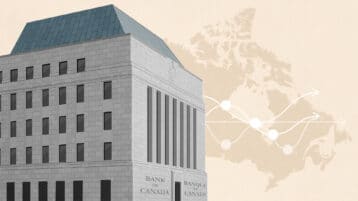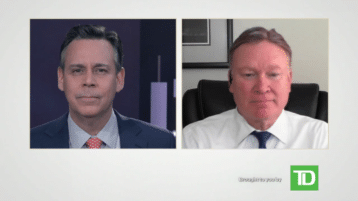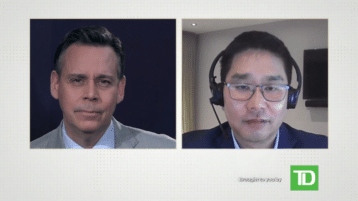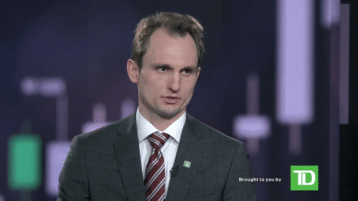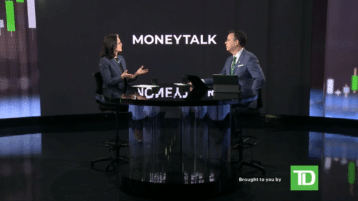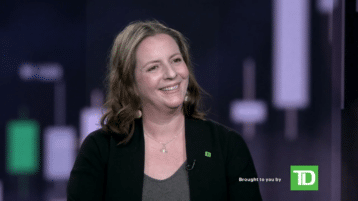Print Transcript
[music] >>Hello I'm Greg Bonnell and welcome to MoneyTalk Live, brought to you by TD Direct Investing.
Every really joined I guess from across TD many of whom you'll only see here.
We'll take you through it's moving the markets and answer questions when investing.
Coming up on today's show, amid sticky inflation we will discuss whether we are really near the end of the hiking cycle and what it means for fixed income with TD Asset Management's Scott Colbourne.
MoneyTalk's Anthony Okolie will of a new report on the outlook for lumber prices.
And in today's WebBroker education segment, Hiren Amin will show us how bond ladders and how they work and how you can create one using WebBroker. Here is how you can get in touch with us, just email MoneyTalk Live it to them.
Or fill out that viewer response box on a video player on WebBroker. We will get you are guests of the day and let's get you first an update of the markets in Toronto the TSX Composite Index. Modestly in negative territory now.
Down about 41 points, 1/5 of a percent. Nothing too dramatic.
I am noticing that the price of crude continues to make gains from the American benchmark, West Texas intermediate, 7247, about 2% on the session now, a bit of a bumpy ride lately.
Concerns about a recession and what would happen if the economy did slow.
Taking a look at Barrick Gold, the price of gold was pulling back today. Nothing too dramatic, 24, 88.
Barrick down about 1.7%.
Crop nutrient company Nutrien is also under some pressure today, by 2 1/2%, two names holding back from a better showing. Now, south of the border, the politicians in Washington continue to wrangle of the debt ceiling.
Although they were sort of talking nice today. Speaker McCarthy was saying "we think we will get something.
Pres. Biden apparently wanting to talk about the debt ceiling this Sunday" may be some optimism out there.
Worst case scenario, the ear the S&P 500 up a little more than half percent. Checking on the tech heavy NASDAQ. That brought a rate of the market.
Pretty much the same, up a little more than half a percent. And Tesla had its annual shareholder meeting yesterday.
Of course a few things always come out of that.
One of them was sort of interesting.
Tesla more in advertising that they're offering.
I don't know if that gets the market exciting but on the heels of that, Tesla a little more than 4%. And that's your market update.
The latest Canadian inflation report shows that it may be a choppy ride to bring higher consumer prices to heal.
Joining us now to discuss what that means for central banks and the fixed income markets is Scott Colbourne, Managing Director for Active Fixed Income at TD Asset Management. Scott great to have you back in the show.
>> Good to be here Greg.
>> This is been an interesting year the fact that is that grinds on, we are not too far away from the halfway point. The assumption that at some point the central banks will be finished their work. Not only pause would be even cut in that could mean things.
Let's look at this Canadian inflation report. Some people are thinking what's going on? Inflation is higher.
>> We are in a difficult point. That transition inflation. A lot of the easy gains are behind us.
I think even Gov. Backlund laid that very nicely saying we are will likely get closer to just over 4% by the end of this year.
We've got median, the meat of inflation year-over-year at around 4.
2%.
Likely we will get closer down to 3%. The tough part is going to get back down to 2% where everybody, from a policy point of view, is the ultimate target.
That will take the bulk of next year.
So it's not an easy… The easy part is over. Now we are transitioning to the dependency.
It is really data dependent. We've had some positive surprises out of the US on the growth side this week.
Some of the Fed governors talking hawkish.
We are in that difficult, choppy environment. That leaves a sort of, if you know, in a bit of a range trading bond market environment with, that is consistent with this transition and inflation.
>> A Canadian report, even for one month, get some tongues wagging in the Bank of Canada. Pretty clear, conditional pause depending on what happens might be hiking again… In the next little while. Is that an overreaction to the report?
>> No. I think it's a fair handicap. I mean, the markets are saying they have not fully priced in a rate hike this year.
Pretty close.
So there is a likely handicap based on your comments and sort of the observations of the central-bank in Canada that they are conditional and data dependent but cleaning hawkish.
So I think we make it one more. I think the bar for June is still pretty high to get a rate hike then.
But certainly they will be talking hawkish. I think they would like a little bit more data the unjust this one inflation… They just paused.
They had one inflation a little stronger than expected.
So I think, you know, the broad parameters suggest, you know, a little bit more of a pause to let the data fill in and see how we transition. At the backdrop is still, we are closer to the end.
>> You talked about the fixed income market being a little range bound. Wait right?
An idea at the end of this year as they get close to the end and perhaps even pause or cut depending on what the market thinks before the end of the year that there is your opportunity in fixed income.
What we need to see now for that opportunity to come true in the second half of the year?
>> Yeah. We rallied about 50 or 70 basis points from the fall.
You know, the end of October until now. So there is been a bit of a rally in rates and, as I say, a range pause of the moment. Look, we haven't had in the long time in fixed income is income.
So, you know, if I told you you're only clipping one and half percent, circa 2020, you know, you're not being paid a lot to wait.
Now you're being paid 3 1/2 to 4%, throw in some credit spreads, it becomes a lot more attractive and that income, as we wait for this transition, to lower yields, lower inflation, you know, there is substantial risk that we have a recession in the US. We keep pushing that out of it but I definitely think the broad strokes suggest that we are going to have a recession.
I think it's more important to debate what type rather than F. But that backdrop even if you have income, you can wait. So you are looking at maybe 3 1/2% at the moment.
The lower end. Maybe we get back closer to 4% in 10 years with a 50 basis point is something you can manage given the level of income at the moment.
>> Let's talk about recession fears, obviously.
Is this part of the thinking as to why the market keeps pricing and cuts?
The market pricing is changed in recent days and weeks based on what's happening with all the data and reports. Maybe pushing the possibility of a cut later to the year. But they still think that the central banks are going to be cutting with the central banks are saying "no, no, no. Once we even pause, we will stay there for a long time" they keep hammering that idea and the markets is no. How do we get that?
>> If you look back in history the Fed would be on pause for maybe 6 to 9 months. Historically right?
Between their last I can with a cut. Look, we came out of the pandemic with these extraordinary policies, these tailwinds that we are still talking about… The San Francisco Fed did in my study saying "look at the peak we had $2.1 trillion in excess savings.
Right?" Now we are down to only half a trillion.
That tailwind is still with us. There is still time. We talk a lot right now about the resilience of the consumer right?
That will teeter out over time. These rates will impact.
Central banks will be patient. Maybe it's not the historic 6 to 9 lines. Maybe it's a little longer.
But ultimately, this is going to bite the consumers.
The credit conditions, the tightening of landing standards that the that we've seen manufacturing project lower. Services being held out by strong consumers. So you know, sometimes it's tough to be patient.
The markets are always wanting a trend. They were wanting to move to inflect but I think the trend is obvious. It's just being patient and waiting for it to play out and maybe central banks will be on hold this year.
But ultimately they will have to cut.
>> When that cut comes relates with the central banks realizes there's too much pain in the economy. They are too restrictive. They have tamp down growth too much.
The argument is been made because of everything we've been through in the pandemic, that perhaps they will allow us to feel a little more pain than usual.
Before they rushed to the rescue yet again. Does that make sense ?
my >> Look, it's a little far out to see if there is a really camera's. But I think the ultimate, you know, the way they phrase it is "we have to restore the balance between supply and demand". If that means Ron hold a little longer, at the end of the day though, we also, going into all this, the Fed talked about having a slightly higher average inflation target over the cycle.
So, maybe while we talk about getting 2%, ultimately they don't get us closer to 2% as we think they will be. So, on the positive side, maybe they stop with the tightening, you know, with pushing back on the demand side earlier than we think.
>> Interesting times.
They definitely call for a bit of patience.
I'm terrible with patients but that's what it calls for.
We'll get back to your questions for Scott Culbert in just a moment's time.
A reminder that you can email us anytime at moneytalklive@td.com or Philip that your response box under the video player on WebBroker.
Now let's get you updated some of the top stories in the world of business and take a look at how the markets are trading.
Target says consumers continue to ship spending towards household essentials and away from big-ticket discretionary items.
The US retailer did beat expectations in its latest quarter, that despite tepid sales growth compared to the same period last year.
Target CEO Bryan Cornell says groceries continue to drive foot traffic despite inflationary pressures. The emergency takeover of credit suites will result in an estimated $17 billion hit for UBS. That's according to a new de la Torre filing from the Swiss bank.
UBS pointed to the short time frame for its due diligence in acquiring credit suites.
That said, UBS also noted it purchased credit suites for a fraction of its big value rather its book value.
Air Canada says it has a new agreement with Fly Dubai for destinations in the Middle East, India and Southern Asia.
The airline says the partnership will allow Air Canada customers to more easily connect with more than 60 destinations ordered or rather offered by Fly Dubai.
Now let's look at the TSX comp index. The price of crude today about 2 1/4%. In South of the border, still wrangling over the debt ceiling. Although we are talking a bit nicer today but the debt ceiling. Made resolutions. It will go on for a few more days at least.
Maybe weeks.
22 points to the upside, little more than half percent of the S&P 500.
We are back with Scott Colbourne taking your questions about fixed income.
Let's start getting to them.
Here we go. Here's the big question off the top: (Greg reads the questions) sees a lot at stake here I guess… >> There is a lot at stake.
It's very serious but it is high political theatre as well.
When you look at the markets right now I would say most of the pressure is reflected in the treasury bond.
I think there was a little support of the government bond market for lower yields because of the uncertainty.
But beyond that, I don't think the financial markets really have handicapped in a riskier.
Given the fact that generally these things are resolved amongst a lot of political theatre, you know, two positives, Pres. Biden coming back Sunday, that's positive. They have narrowed their team of negotiators to a smaller group.
That is a positive.
So broadly speaking, slightly positive vibes are being emanated.
From the negotiations.
If they do default, I mean, that is a real negative.
The currency will take, in my opinion, a hit on that and I think ultimately this is a contraction of demand in the US right?
Withholding payments to people and as they prioritize the cash flows.
And so I think it would be quite a negative to undermine the US completely.
>> Last time we went through this, if my history suits serves me well more than to dedicate a decade ago, the debt ceiling debate, on the other and of course there was all they got on with but I think the America's credit rating took a bit of a hit off of that.
>> They will be luckily a downgrade of the data and ultimately, long run is an of the trip and the Armour another chip in the Armour.
> Perhaps the question, reading past with the viewer was saying, I want to talk about D dollarization lately.
Not necessarily the debt crisis but the American but just won't be as dominant. Is that something, when you take a look at the markets, that's a real concern?
>> I think that's great. In the Internet sphere. The reality of the substitution of the US dollar is pretty low.
There really has to be some recycling of, for a lot of countries they will have access used dollars based on trade flows. Where you put it?
You put it in the most liquid market.
If your counterparty is some miner country, where you recycle it in?
Lobar markets? No.
Sizes don't exist.
Low bond markets that is? It's a very slow process.
You have to have markets that can absolutely… Recycle the surpluses from trade.
There is very few markets out there that are able to do that. So it's a long, it's a nice cliché at the moment.
But I don't see any risk from it.
>> Interesting points on that.
Let's get to another question now. A viewer says (Greg reads the question) okay. We can't give you advice on timing of the market but if somebody was looking at fixed income outside of these borders, what we think?
>> When we look at our opportunities, asset allocation within fixed income, domestic and then you know, the ubiquitous market and stepping out there are markets like Europe, UK, Virgin markets and we definitely invest in those.
One way that we look at it is hedging the currency back into the US. So you look at the yield differential between Canada and the US and Europe and then also the currency forward. Definitely there is opportunities abroad.
Then we are taking advantage of right now.
Local emerging-market debt is very attractive. We have been focused, we've had are focused we've had our attention focused on some of the Latin American countries lately.
They have very high yields and central banks to tighten well in advance of the developed market.
I think they offer some interesting opportunities and they have currencies with exception of the Mexican peso, some of the Latin American countries there currencies are still the cheap side.
So I think it makes sense. It's not as liquid as market as Canadian and US bond markets. You have to take a patient perspective on these markets. But they offer very attractive yields and they are nice compliments to the sort of core investments in Canada.
> Will be the biggest risks if somebody was thinking about emerging-market strategies?
>> There is always risks. Broadly speaking I'm a proponent that the US dollar is weakening. Since its peak in late fall of last year. I think it continues so that's up positive for emerging-market prices so that devaluation could happen. There always these random situation in these countries. It's always hard to keep a close eye on. So that could come out of the blue. And liquidity.
I mean they are just not as liquid as local markets. So you have to be mindful.
I always think of it in terms of sizing.
How you size your investments. What type of allocation you can make to these investments.
>> Let's take another question now. This one about perhaps what we should be worried about in this country. Should Canadians be worried about what's happening in those banks in the United States?
>> Look, the rapid increase in interest rates has had a profound impact on the banking, the nature of banking in the US and Canada right?
Given the fact that, the starting point was essentially zero.
And so there has been a lot of rebalancing in the portfolios. There has been some of the banks, particularly in the US, bond, regional nature, we have seen a business model that is an exposed as to highly concentrated.
So they have put at risk.
I'm not worried with the Canadian banks at all. I mean, you know, they are big, well-capitalized, well regulated, so that's not a concern of mine. But it just highlights a headwind and how that ultimately feeds into the economy, I think, is more important given the fact that there is retrenchment going on given these headwinds of the banks in Canada and the US. Their lending will be tightened. They will not be as generous to whether a small or medium-size businesses in the US or broad businesses.
It's good to have an impact and that feeds through into demand.
That's more important for me.
>> I think the Fed and chair Powell admitted the past couple of times that we have an opportunity to hear from them on the matter that it doesn't work for them.
If credit will tighten, that's what they've been trying to achieve through higher interest rates as well. They are just not sure how much.
>> Yeah and it's this patient's notion right? These things are not as that you cannot we see the price change on a day-to-day basis on tightening credit right? It feeds through the data.
It comes to a slower.
But we know it's going to have an impact.
Some of the best guesses or feedback that we are getting is from some of the surveying information that tells us that the thought last week in Canada it was the Bank of Canada was tightening. Financial challenges are in the credit channel through tightening and lending on mortgages. So we know that's in a fee through the next three, six, nine months. Same thing in the US. We had some of the regional surveys, support smaller surveys tell us that they are coming back to small and medium-size businesses so.
Yeah. We know it's coming it's just hard to see it on a day-to-day basis.
>> As always at home make sure you do your own research before making any investment decisions.
We will get back to your questions with Scott Colbourne on fixed income in just a moment's time.
A reminder of course that you get intention is any time by emailing moneytalklive@td.
com. Now if it were educational segment of the day.
We are talking fixed income so let's talk bond laddering. It is one fixed income strategy investors may consider using and here to show us how they work and how you can create one on WebBroker's Hiren Amin, Senior Client Education Instructor with TD Direct Investing.
Walkers throughout bond ladders work.
>> Great to be back here again.
The stock of a bond laddering.
As you mentioned, one of the strategies that investors were fixed income oriented can look to set up their portfolio. So essentially, a bond letter is a portfolio bond that is going to be maturing on different different dates.
So the strategy is designed to provide current income while minimizing the exposure of interest rate fluctuations. Just so everyone knows, remember, bond pricing is inversely related to interest rates. So when interest rates rise, bond prices tend to fall. So, instead of just buying bonds that tend to be scheduled to mature in the same year, you're the purchasing bonds that mature at these a staggered future dates. Now by spreading out this maturity, it helps prevent investors from trying to time the market but also helps to stay disciplined and reinvest in those proceeds from those maturing bonds. It can also help right out some of those interest rate fluctuations that we will tend to see. Especially with this chatter about may be potentially where interest rates go from here.
So two primary goals are really to manage those interest-rate risks.
Not forcing us to have one single bond with a single fixed interest rate. So smoothing out those fluctuations in thinking of all it will manage the cash flow because bonds pay interest on a semiannual basis.
So if you are able to structure a portfolio where you have these different maturity dates on a semiannual basis, you can generate income flow coming on a monthly basis.
And also another benefit to this is you are able to have cash that is going to be liquid. In case you have other obligations that you need for there.
>> A nice understanding out of what bond lettering is and why someone would want to do it. Let's talk about WebBroker and how to create one.
>> Absolutely.
We will step in to WebBroker now. To create a bond letter, it is a fairly straightforward process. I will start by getting to our fixed income pager.
A couple of things to keep in mind when doing this. You have to determine how much you're looking to invest.
What kind of Securities you want to have as a makeup than in the portfolio?
And then deciding the spacing between them.
We will talk about that.
A general search here, I will keep it very broad-based.
I wanted to do a mixed bag, my main priority will be making sure that I have income coming through on a monthly basis. So, if I bring up the surgery here… Through our fixed income search I will capture everything available.
But I want to narrow it down to US currency based bonds.
Mainly because I am really looking at their benchmark rates that are a little higher than we are right now. I will do this broad search. Keep in mind investors will use more in terms of picking their bonds and allocating based on different classes available there as well as credit ratings. So, when I hit the submit button I will have a list of all these different bonds that are captured here.
Now, what I'm gonna do with my example, I'm going to assume we have $30,000 to invest that bond portfolio in a minute be using six rangs as part of my letter. If I use six bonds, we will split that 30,000 into the six which is 5000 each, we will be looking to collect income on a monthly basis. I have already kind of pre-filtered and picked out those ladders. So I will go into my portfolio here and we are to have a five-year ladder created. If I click onto it, our viewers can see what we have here. So I think these staggered dates that are maturing every year starting in 2024. All the way to 2029.
It's a mixed bag of US corporation bonds as well as U.S. Treasury bonds here.
We are doing $5000 locations. The total cost right now is coming up to 29,128. You can have a breakdown of some of the numbers and you can see a report available in WebBroker. So I want to create a ladder report over here, I actually have it cued up here.
So I will pull this report appear this is what shows up.
You can see it gives you a breakdown of your total amounts.
It tells me this section over here is all my corporate bonds I have. These are my U.S. Treasury bonds, 30,000.
Now this amount, my market value right now, this is converting back the Canadian dollars based on the amount of the 29,000 that we have.
But it also gives me my annualized yield that I have across all these portfolios with income that I'm generating. So in short Greg, that is how you would get set up with a bond letter using WebBroker tools we have over here.
>> Great stuff as always. Thanks for that.
>> My pleasure is always great. Enjoy your day.
>> You two.
Hiren Amin, Senior Client Education Instructor TD Direct Investing.
Make sure to check out WebBroker's has a learning centre for more educational videos, live interactive master classes and upcoming webinars.
And now are a reminder of height get in touch us.
Do you have a question about investing, or what is driving the markets? Our guests are eager to answer your questions so send them to us here at MoneyTalk Live. You can send your questions two ways: you can send us an email any time at moneytalklive@td.com or you can use the question box at the bottom screen right here on WebBroker just type your question and hit "send". We will see if one of our guests can get you the answer right here at MoneyTalk Live!
We are back with Scott Colborne taking your questions what fixed income. A lot coming and select start getting through some of them.
Is there a growing risk in a high-yield sector?
>> Well, if we expect the economy to move towards a recession we would expect credit spreads both investment grade and high-yield to widen from where they are roughly 500 basis points and in US high-yield right now.
So maybe they get to 600. Right now default rates are pretty well contained around 2%.
The markets have already forecast a move to 4% so that's average over cycle.
So it's a question of moving beyond that. In general spreads moving beyond with credit, lending biases like we've Artie talked about. That's tightening. That being said, there's been some positives for high-yield.
What we call rising stars.
The credits that move from the high-yield to the investment-grade universe. They have actually, there is been a lot of those this year.
At the end of last year as well. So the actual supplier of the universe of high-yield has shrugged.
>> Really?
>> They've had less issues.
There is a bit of a technical backdrop that supportive of high-yield. Maybe not as wide as the, you know, should be right now given the supply support. So I think ultimately drifting wider there will be an opportunity, we believe later this year.
But you've gotta handicap some of these technical factors in play as well.
>> Me the reason why the yield is high in high yields is because you are taking on greater risk.
People doing their homework, what are they looking for in researching a company? Is it the same as the equity investors are looking for?
>> Absolutely. But at the end the day it's the ability to pay their debt right? That's first and foremost.
Obviously, with higher-yielding companies, there's more of a handicap or risk so a lot of work to do. You have to understand high-yield debt and what companies can and cannot do. In terms of managing their cash flows.
That's very important as well. So, I love the asset class ultimately in the long run. I look at it from an asset allocation point of view. If you think that equities give you seven, eight, 9% long run returns, the volatility of high-yield is about 1/3 of the equity market. And gives you the same sort of return. So, when you bind a basket.
>> Things to consider there. If you're looking into that space, here's a headline I think it just broke yesterday. Any thoughts on that potentially huge Pfizer issuance?
>> So this speaks to the markets we are in right now.
A little choppy, a little rangy.
But it has been the backdrop at least on the equity market that is been accommodative. So we've seen a number of issues come to the market. That was, I think the fourth-largest debt issuance deal and certainly the largest this year in the US investment grade market. It was about $31 billion in supply. So it was well received. It was priced up yesterday. A little tighter from where was issued. So that is, that speaks to the ability of the market to observe the supply and sometimes that contributes to hedging activity which contributes to slightly higher government bond yields.
But, that washes over time. I think it's a positive sign that companies are looking to refinance, build up the war chest. US investment grade has been slowly drifting wider, the net, and that speaks to the longer run which we touched on in high-yield.
Tighter credit lending and that ultimately leads to the cost of borrowing going up over time.
>> The fact that Pfizer issuance was well received by the market, big companies looking and saying "maybe this is an option for us to".
>> When I left my desk I think it was about 10 deals today. On the back of good issuance that leads to more supply.
> Interesting stuff.
This one back here at home, the Bank of Canada… Will he remain on pause after that hotter than expected inflation print?
>> It's a close call for June. That's the next one, June 7. Right now, the market is saying "no they're not going to hike despite that" but ultimately whether it's July or later, maybe in September, the markets are handicapping almost a full pricing of the hike. To the market at the moment is leaning towards them probably going again. You know, it's a tough call. As he is much beyond that if we do go again in terms of sustained Hayek's in, you know the Canadian bond market.
>> We are to get back your questions for Scott Colbourne on fixed income in just a moment's time. As always, make sure you do your own research before making any investment decisions and a reminder that you can get in touch with us at any time.
Do you have a question about investing, or what is driving the markets? Our guests are eager to answer your questions so send them to us here at MoneyTalk Live. You can send your questions two ways: you can send us an email any time at moneytalklive@td.com or, you can use the question box right below this screen right here on WebBroker. Just writing your question and hit "send".
We will see if one of our guests and get you the answer you need right here at MoneyTalk Live.
Lumber prices are falling to their lowest level in more than two years, since central banks took aim at stubbornly high inflation and the overheated housing market. Our Anthony Okolie joins us from TD Securities with the latest report on recent trends and their outlook on the paper in Forest products sector Anthony!
>> Thanks Greg. The performance of the universe of forest product companies underperformed the broader market indices last week. This comes as lumber prices continue to struggle for direction.
And prices of course crashing in the early days of the 2020 lockdown, they exploded that some are as households renovated their homes.
The market search. Of course with the Fed hiking rates in March 2022, lumber was among the first assets to deflate.
Lumber future actually ended around three to $40 US on Friday. That's well below the May 2022 peak of around $1700. Now, three years ago, soaring prices is signalled hoarding among many builders were worried about running out of wood.
Again, looking at these trends this year, buyers are more concerned with expenses of stockpiling lumber because of higher rates. Cooling housing markets.
Then about not receiving their orders.
Now, this was punctuated this week when Home Depot posted its biggest sales miss since 2002 in the first quarter amid slumping lumber prices as well as softer demand.
In addition, TD Economics noted that despite Canadian housing starts writing in April rather rising in April, housing starts remain on a downward trend and past home sales are actually passing through to weaker homebuilding.
Now, TD Securities believes that North American lumber pricing momentum is flat to negative despite favourable weather and seasonal tailwinds.
They note that European lumber imports have pressured prices and that has helped to offset some of those tailwinds that they are seeing. Meanwhile, TD Securities says that pulp prices are also under increasing pressure.
With prices dropping to the lowest levels since February 2022.
And at current prices, TD Securities believes the Western Canadian pulp mills have poor cash flow.
TD Securities assessment weaker paper and market demand chiefly from China which consumes roughly 40% of the global pulp market has really upended prices in active course making it very challenging of an environment for the paper in Forest products sector.
Greg.
> You mention whether of course.
The nice weather is here. If you build, it's not a bad time.
What is TD Securities think about the inventory levels as we head into building season?
>> Inventory buildup obviously reflects the sawmills per of preparing ahead of the spring building season.
Based on their announces, TD Securities said that sawmills goods and inventories increased 1.5% quarter over quarter. But they still remain at a seven-year low. TD Securities also absorbed that sawmill inventories have declined significant for the first quarter of 2022 peak on the back of production since the second half of last year and that would be towards BC, one of the world's largest exports of forest products. Greg?
>> At home, if the partner says it's time to build, they are often told it's too expensive. My fallback is "my back is would not what used to be" but the response is so why don't we just hire somebody with younger stronger back.
I think all my excuses are not working. Thanks Anthony.
>> Thanks Greg.
>> MoneyTalk Live's Anthony Okolie.
Let's see what's happening at home. The TSX Composite Index, we are seeing a push higher in crude oil but it's not lifting the broader market. 28 points.
Nothing too dramatic a little more than 1/10 of a percent. Air Canada we talked about earlier in the program, losing their share is indeed a 22, 81.
Up more than 5 1/2%.
A bit of weakness in the gold names now.
As far as the pack of gold miners go it's getting a little harder.
374, down a little more than 5%.
LightSpeed making some gains today on deck to report its latest quarterly report tomorrow morning.
Building throughout the session. Up about 9% ahead of that earnings report.
Taking a look south of the border, the S&P 500, the debt ceiling negotiations continue.
Both sides are saying more constructive things today.
At least nothing negative things today. So you have the S&P 500 up a modest 20 points.
The tech heavy NASDAQ lacking a little now.
Up about 1/2 a percent.
Target favouring what you actually need in your house like groceries and discretionary goods but perhaps some of the chatter out there seems to be the point that perhaps after Home Depot yesterday, the disappointment they are, they decided the target is a good enough for what they showed us this quarter. 160 bucks up a little more than 2% to share.
We are back now is Scott Colbourne from TD Asset Management. Tony but fixed income.
Taking more of your questions. So he wants to know if the central banks are actually making inflation worse by raising rates?
They are increasing the cost of things for us. The cost of money.
>> Yeah. The short answer is no. They are not making inflation with their policies. But they have a huge impact on the allocation of capital.
You know, I think that when you look back, since the great financial crisis, almost 75, 80% of the time, rates were at zero.
And all of a sudden, you know, post pandemic, from a variety of policies, we've got inflation. So I would almost argue it's the opposite.
It's not raising rates that contribute into inflation it's the misallocation of rates going into it that led to a distortion in the price of money. Interest is the price of money.
Interest is the price of time, sorry. And when we miss allocate and put wrong pricing on that, now we are dealing with thank crisis and private credit problems, commercial real estate, and FTs, all these things came from cheap money. And that is ultimately being destroyed.
And now, we have had the shock of the pandemic causing inflation and now there are so many forces at play that there's only so many levers that the Central Bank has and part of it is to reign in demand. And that's what they're doing.
Yes, it's causing the price of servicing your debt on a variety of things, whether it's housing or consumption.
But that's what they have to do. That's not contributing to inflation. Inflation was probably based on the fact that money was too cheap.
>> Let's get to another question here, given that inflation is been sticky. A viewer wants to know maybe another hike from the Bank of Canada, will GIC rates rise?
>> GIC rates are based off of, it's a tool that the banks have. To raise deposits.
They price it off when spaced in the financial bond markets. So I would say, you know, going back to her first comments the beginning, markets have been ranging.
The easy part of higher GIC rates is over. It will depend on the institution. Whether they raise rates given the slight adjustment upward and yields over the last day or two.
You know, it's an expensive way of raising deposits. So some may not raise rates despite the fact that inflation is sticky and despite the fact that the Bank of Canada may raise rates again within a year. So, I think the easy money in terms of repricing GIC is over.
>> We have time for one more.
The debt ceiling debate in the risk of the fault, definitely on a lot of people's minds. If the US did default, what can the Fed do? We are so used to central banks arriving to the rescue.
>> Don't look to us to bail you out. This is a problem of your own making and it's a political problem and it's a… Over you. I think the likelihood of this happening is pretty small.
But, we have seen a repricing in credit default swap market for the US one year.
Arete is up massively since the earlier time of this year. I think at the end of the day, it'll get resolved. I think the bigger question is what happens afterwards? We might of this euphoria but I think if you step back and really realize what's coming your way, it will probably mean that we've had some expenditure cutbacks so a tighter fiscal policy… The Democrats will probably accommodate that and then there's a slew of issues in the bond market that has been, you know, tempered somewhat. Particularly the front end of the market. So you have some duration issues.
I.e. higher yields that come out of it. So you will probably get a sugar belief in the aftermath of some resolution but looking through that, there some headwinds for the bond market and for you know, the balance between monetary policy and fiscal policy.
>> Always fascinating conversation Scott we look forward to the next one.
Our thanks to Scott Colbourne, Managing Director for Active Fixed Income at TD Asset Management and stated on Thursday, David Tong, senior analyst with Argus research will be our guest take your questions about healthcare stocks a reminder to get in touch with us any time by emailing MoneyTalk Live ATD.com. That's all the time for our show. Take care!
[music]
Every really joined I guess from across TD many of whom you'll only see here.
We'll take you through it's moving the markets and answer questions when investing.
Coming up on today's show, amid sticky inflation we will discuss whether we are really near the end of the hiking cycle and what it means for fixed income with TD Asset Management's Scott Colbourne.
MoneyTalk's Anthony Okolie will of a new report on the outlook for lumber prices.
And in today's WebBroker education segment, Hiren Amin will show us how bond ladders and how they work and how you can create one using WebBroker. Here is how you can get in touch with us, just email MoneyTalk Live it to them.
Or fill out that viewer response box on a video player on WebBroker. We will get you are guests of the day and let's get you first an update of the markets in Toronto the TSX Composite Index. Modestly in negative territory now.
Down about 41 points, 1/5 of a percent. Nothing too dramatic.
I am noticing that the price of crude continues to make gains from the American benchmark, West Texas intermediate, 7247, about 2% on the session now, a bit of a bumpy ride lately.
Concerns about a recession and what would happen if the economy did slow.
Taking a look at Barrick Gold, the price of gold was pulling back today. Nothing too dramatic, 24, 88.
Barrick down about 1.7%.
Crop nutrient company Nutrien is also under some pressure today, by 2 1/2%, two names holding back from a better showing. Now, south of the border, the politicians in Washington continue to wrangle of the debt ceiling.
Although they were sort of talking nice today. Speaker McCarthy was saying "we think we will get something.
Pres. Biden apparently wanting to talk about the debt ceiling this Sunday" may be some optimism out there.
Worst case scenario, the ear the S&P 500 up a little more than half percent. Checking on the tech heavy NASDAQ. That brought a rate of the market.
Pretty much the same, up a little more than half a percent. And Tesla had its annual shareholder meeting yesterday.
Of course a few things always come out of that.
One of them was sort of interesting.
Tesla more in advertising that they're offering.
I don't know if that gets the market exciting but on the heels of that, Tesla a little more than 4%. And that's your market update.
The latest Canadian inflation report shows that it may be a choppy ride to bring higher consumer prices to heal.
Joining us now to discuss what that means for central banks and the fixed income markets is Scott Colbourne, Managing Director for Active Fixed Income at TD Asset Management. Scott great to have you back in the show.
>> Good to be here Greg.
>> This is been an interesting year the fact that is that grinds on, we are not too far away from the halfway point. The assumption that at some point the central banks will be finished their work. Not only pause would be even cut in that could mean things.
Let's look at this Canadian inflation report. Some people are thinking what's going on? Inflation is higher.
>> We are in a difficult point. That transition inflation. A lot of the easy gains are behind us.
I think even Gov. Backlund laid that very nicely saying we are will likely get closer to just over 4% by the end of this year.
We've got median, the meat of inflation year-over-year at around 4.
2%.
Likely we will get closer down to 3%. The tough part is going to get back down to 2% where everybody, from a policy point of view, is the ultimate target.
That will take the bulk of next year.
So it's not an easy… The easy part is over. Now we are transitioning to the dependency.
It is really data dependent. We've had some positive surprises out of the US on the growth side this week.
Some of the Fed governors talking hawkish.
We are in that difficult, choppy environment. That leaves a sort of, if you know, in a bit of a range trading bond market environment with, that is consistent with this transition and inflation.
>> A Canadian report, even for one month, get some tongues wagging in the Bank of Canada. Pretty clear, conditional pause depending on what happens might be hiking again… In the next little while. Is that an overreaction to the report?
>> No. I think it's a fair handicap. I mean, the markets are saying they have not fully priced in a rate hike this year.
Pretty close.
So there is a likely handicap based on your comments and sort of the observations of the central-bank in Canada that they are conditional and data dependent but cleaning hawkish.
So I think we make it one more. I think the bar for June is still pretty high to get a rate hike then.
But certainly they will be talking hawkish. I think they would like a little bit more data the unjust this one inflation… They just paused.
They had one inflation a little stronger than expected.
So I think, you know, the broad parameters suggest, you know, a little bit more of a pause to let the data fill in and see how we transition. At the backdrop is still, we are closer to the end.
>> You talked about the fixed income market being a little range bound. Wait right?
An idea at the end of this year as they get close to the end and perhaps even pause or cut depending on what the market thinks before the end of the year that there is your opportunity in fixed income.
What we need to see now for that opportunity to come true in the second half of the year?
>> Yeah. We rallied about 50 or 70 basis points from the fall.
You know, the end of October until now. So there is been a bit of a rally in rates and, as I say, a range pause of the moment. Look, we haven't had in the long time in fixed income is income.
So, you know, if I told you you're only clipping one and half percent, circa 2020, you know, you're not being paid a lot to wait.
Now you're being paid 3 1/2 to 4%, throw in some credit spreads, it becomes a lot more attractive and that income, as we wait for this transition, to lower yields, lower inflation, you know, there is substantial risk that we have a recession in the US. We keep pushing that out of it but I definitely think the broad strokes suggest that we are going to have a recession.
I think it's more important to debate what type rather than F. But that backdrop even if you have income, you can wait. So you are looking at maybe 3 1/2% at the moment.
The lower end. Maybe we get back closer to 4% in 10 years with a 50 basis point is something you can manage given the level of income at the moment.
>> Let's talk about recession fears, obviously.
Is this part of the thinking as to why the market keeps pricing and cuts?
The market pricing is changed in recent days and weeks based on what's happening with all the data and reports. Maybe pushing the possibility of a cut later to the year. But they still think that the central banks are going to be cutting with the central banks are saying "no, no, no. Once we even pause, we will stay there for a long time" they keep hammering that idea and the markets is no. How do we get that?
>> If you look back in history the Fed would be on pause for maybe 6 to 9 months. Historically right?
Between their last I can with a cut. Look, we came out of the pandemic with these extraordinary policies, these tailwinds that we are still talking about… The San Francisco Fed did in my study saying "look at the peak we had $2.1 trillion in excess savings.
Right?" Now we are down to only half a trillion.
That tailwind is still with us. There is still time. We talk a lot right now about the resilience of the consumer right?
That will teeter out over time. These rates will impact.
Central banks will be patient. Maybe it's not the historic 6 to 9 lines. Maybe it's a little longer.
But ultimately, this is going to bite the consumers.
The credit conditions, the tightening of landing standards that the that we've seen manufacturing project lower. Services being held out by strong consumers. So you know, sometimes it's tough to be patient.
The markets are always wanting a trend. They were wanting to move to inflect but I think the trend is obvious. It's just being patient and waiting for it to play out and maybe central banks will be on hold this year.
But ultimately they will have to cut.
>> When that cut comes relates with the central banks realizes there's too much pain in the economy. They are too restrictive. They have tamp down growth too much.
The argument is been made because of everything we've been through in the pandemic, that perhaps they will allow us to feel a little more pain than usual.
Before they rushed to the rescue yet again. Does that make sense ?
my >> Look, it's a little far out to see if there is a really camera's. But I think the ultimate, you know, the way they phrase it is "we have to restore the balance between supply and demand". If that means Ron hold a little longer, at the end of the day though, we also, going into all this, the Fed talked about having a slightly higher average inflation target over the cycle.
So, maybe while we talk about getting 2%, ultimately they don't get us closer to 2% as we think they will be. So, on the positive side, maybe they stop with the tightening, you know, with pushing back on the demand side earlier than we think.
>> Interesting times.
They definitely call for a bit of patience.
I'm terrible with patients but that's what it calls for.
We'll get back to your questions for Scott Culbert in just a moment's time.
A reminder that you can email us anytime at moneytalklive@td.com or Philip that your response box under the video player on WebBroker.
Now let's get you updated some of the top stories in the world of business and take a look at how the markets are trading.
Target says consumers continue to ship spending towards household essentials and away from big-ticket discretionary items.
The US retailer did beat expectations in its latest quarter, that despite tepid sales growth compared to the same period last year.
Target CEO Bryan Cornell says groceries continue to drive foot traffic despite inflationary pressures. The emergency takeover of credit suites will result in an estimated $17 billion hit for UBS. That's according to a new de la Torre filing from the Swiss bank.
UBS pointed to the short time frame for its due diligence in acquiring credit suites.
That said, UBS also noted it purchased credit suites for a fraction of its big value rather its book value.
Air Canada says it has a new agreement with Fly Dubai for destinations in the Middle East, India and Southern Asia.
The airline says the partnership will allow Air Canada customers to more easily connect with more than 60 destinations ordered or rather offered by Fly Dubai.
Now let's look at the TSX comp index. The price of crude today about 2 1/4%. In South of the border, still wrangling over the debt ceiling. Although we are talking a bit nicer today but the debt ceiling. Made resolutions. It will go on for a few more days at least.
Maybe weeks.
22 points to the upside, little more than half percent of the S&P 500.
We are back with Scott Colbourne taking your questions about fixed income.
Let's start getting to them.
Here we go. Here's the big question off the top: (Greg reads the questions) sees a lot at stake here I guess… >> There is a lot at stake.
It's very serious but it is high political theatre as well.
When you look at the markets right now I would say most of the pressure is reflected in the treasury bond.
I think there was a little support of the government bond market for lower yields because of the uncertainty.
But beyond that, I don't think the financial markets really have handicapped in a riskier.
Given the fact that generally these things are resolved amongst a lot of political theatre, you know, two positives, Pres. Biden coming back Sunday, that's positive. They have narrowed their team of negotiators to a smaller group.
That is a positive.
So broadly speaking, slightly positive vibes are being emanated.
From the negotiations.
If they do default, I mean, that is a real negative.
The currency will take, in my opinion, a hit on that and I think ultimately this is a contraction of demand in the US right?
Withholding payments to people and as they prioritize the cash flows.
And so I think it would be quite a negative to undermine the US completely.
>> Last time we went through this, if my history suits serves me well more than to dedicate a decade ago, the debt ceiling debate, on the other and of course there was all they got on with but I think the America's credit rating took a bit of a hit off of that.
>> They will be luckily a downgrade of the data and ultimately, long run is an of the trip and the Armour another chip in the Armour.
> Perhaps the question, reading past with the viewer was saying, I want to talk about D dollarization lately.
Not necessarily the debt crisis but the American but just won't be as dominant. Is that something, when you take a look at the markets, that's a real concern?
>> I think that's great. In the Internet sphere. The reality of the substitution of the US dollar is pretty low.
There really has to be some recycling of, for a lot of countries they will have access used dollars based on trade flows. Where you put it?
You put it in the most liquid market.
If your counterparty is some miner country, where you recycle it in?
Lobar markets? No.
Sizes don't exist.
Low bond markets that is? It's a very slow process.
You have to have markets that can absolutely… Recycle the surpluses from trade.
There is very few markets out there that are able to do that. So it's a long, it's a nice cliché at the moment.
But I don't see any risk from it.
>> Interesting points on that.
Let's get to another question now. A viewer says (Greg reads the question) okay. We can't give you advice on timing of the market but if somebody was looking at fixed income outside of these borders, what we think?
>> When we look at our opportunities, asset allocation within fixed income, domestic and then you know, the ubiquitous market and stepping out there are markets like Europe, UK, Virgin markets and we definitely invest in those.
One way that we look at it is hedging the currency back into the US. So you look at the yield differential between Canada and the US and Europe and then also the currency forward. Definitely there is opportunities abroad.
Then we are taking advantage of right now.
Local emerging-market debt is very attractive. We have been focused, we've had are focused we've had our attention focused on some of the Latin American countries lately.
They have very high yields and central banks to tighten well in advance of the developed market.
I think they offer some interesting opportunities and they have currencies with exception of the Mexican peso, some of the Latin American countries there currencies are still the cheap side.
So I think it makes sense. It's not as liquid as market as Canadian and US bond markets. You have to take a patient perspective on these markets. But they offer very attractive yields and they are nice compliments to the sort of core investments in Canada.
> Will be the biggest risks if somebody was thinking about emerging-market strategies?
>> There is always risks. Broadly speaking I'm a proponent that the US dollar is weakening. Since its peak in late fall of last year. I think it continues so that's up positive for emerging-market prices so that devaluation could happen. There always these random situation in these countries. It's always hard to keep a close eye on. So that could come out of the blue. And liquidity.
I mean they are just not as liquid as local markets. So you have to be mindful.
I always think of it in terms of sizing.
How you size your investments. What type of allocation you can make to these investments.
>> Let's take another question now. This one about perhaps what we should be worried about in this country. Should Canadians be worried about what's happening in those banks in the United States?
>> Look, the rapid increase in interest rates has had a profound impact on the banking, the nature of banking in the US and Canada right?
Given the fact that, the starting point was essentially zero.
And so there has been a lot of rebalancing in the portfolios. There has been some of the banks, particularly in the US, bond, regional nature, we have seen a business model that is an exposed as to highly concentrated.
So they have put at risk.
I'm not worried with the Canadian banks at all. I mean, you know, they are big, well-capitalized, well regulated, so that's not a concern of mine. But it just highlights a headwind and how that ultimately feeds into the economy, I think, is more important given the fact that there is retrenchment going on given these headwinds of the banks in Canada and the US. Their lending will be tightened. They will not be as generous to whether a small or medium-size businesses in the US or broad businesses.
It's good to have an impact and that feeds through into demand.
That's more important for me.
>> I think the Fed and chair Powell admitted the past couple of times that we have an opportunity to hear from them on the matter that it doesn't work for them.
If credit will tighten, that's what they've been trying to achieve through higher interest rates as well. They are just not sure how much.
>> Yeah and it's this patient's notion right? These things are not as that you cannot we see the price change on a day-to-day basis on tightening credit right? It feeds through the data.
It comes to a slower.
But we know it's going to have an impact.
Some of the best guesses or feedback that we are getting is from some of the surveying information that tells us that the thought last week in Canada it was the Bank of Canada was tightening. Financial challenges are in the credit channel through tightening and lending on mortgages. So we know that's in a fee through the next three, six, nine months. Same thing in the US. We had some of the regional surveys, support smaller surveys tell us that they are coming back to small and medium-size businesses so.
Yeah. We know it's coming it's just hard to see it on a day-to-day basis.
>> As always at home make sure you do your own research before making any investment decisions.
We will get back to your questions with Scott Colbourne on fixed income in just a moment's time.
A reminder of course that you get intention is any time by emailing moneytalklive@td.
com. Now if it were educational segment of the day.
We are talking fixed income so let's talk bond laddering. It is one fixed income strategy investors may consider using and here to show us how they work and how you can create one on WebBroker's Hiren Amin, Senior Client Education Instructor with TD Direct Investing.
Walkers throughout bond ladders work.
>> Great to be back here again.
The stock of a bond laddering.
As you mentioned, one of the strategies that investors were fixed income oriented can look to set up their portfolio. So essentially, a bond letter is a portfolio bond that is going to be maturing on different different dates.
So the strategy is designed to provide current income while minimizing the exposure of interest rate fluctuations. Just so everyone knows, remember, bond pricing is inversely related to interest rates. So when interest rates rise, bond prices tend to fall. So, instead of just buying bonds that tend to be scheduled to mature in the same year, you're the purchasing bonds that mature at these a staggered future dates. Now by spreading out this maturity, it helps prevent investors from trying to time the market but also helps to stay disciplined and reinvest in those proceeds from those maturing bonds. It can also help right out some of those interest rate fluctuations that we will tend to see. Especially with this chatter about may be potentially where interest rates go from here.
So two primary goals are really to manage those interest-rate risks.
Not forcing us to have one single bond with a single fixed interest rate. So smoothing out those fluctuations in thinking of all it will manage the cash flow because bonds pay interest on a semiannual basis.
So if you are able to structure a portfolio where you have these different maturity dates on a semiannual basis, you can generate income flow coming on a monthly basis.
And also another benefit to this is you are able to have cash that is going to be liquid. In case you have other obligations that you need for there.
>> A nice understanding out of what bond lettering is and why someone would want to do it. Let's talk about WebBroker and how to create one.
>> Absolutely.
We will step in to WebBroker now. To create a bond letter, it is a fairly straightforward process. I will start by getting to our fixed income pager.
A couple of things to keep in mind when doing this. You have to determine how much you're looking to invest.
What kind of Securities you want to have as a makeup than in the portfolio?
And then deciding the spacing between them.
We will talk about that.
A general search here, I will keep it very broad-based.
I wanted to do a mixed bag, my main priority will be making sure that I have income coming through on a monthly basis. So, if I bring up the surgery here… Through our fixed income search I will capture everything available.
But I want to narrow it down to US currency based bonds.
Mainly because I am really looking at their benchmark rates that are a little higher than we are right now. I will do this broad search. Keep in mind investors will use more in terms of picking their bonds and allocating based on different classes available there as well as credit ratings. So, when I hit the submit button I will have a list of all these different bonds that are captured here.
Now, what I'm gonna do with my example, I'm going to assume we have $30,000 to invest that bond portfolio in a minute be using six rangs as part of my letter. If I use six bonds, we will split that 30,000 into the six which is 5000 each, we will be looking to collect income on a monthly basis. I have already kind of pre-filtered and picked out those ladders. So I will go into my portfolio here and we are to have a five-year ladder created. If I click onto it, our viewers can see what we have here. So I think these staggered dates that are maturing every year starting in 2024. All the way to 2029.
It's a mixed bag of US corporation bonds as well as U.S. Treasury bonds here.
We are doing $5000 locations. The total cost right now is coming up to 29,128. You can have a breakdown of some of the numbers and you can see a report available in WebBroker. So I want to create a ladder report over here, I actually have it cued up here.
So I will pull this report appear this is what shows up.
You can see it gives you a breakdown of your total amounts.
It tells me this section over here is all my corporate bonds I have. These are my U.S. Treasury bonds, 30,000.
Now this amount, my market value right now, this is converting back the Canadian dollars based on the amount of the 29,000 that we have.
But it also gives me my annualized yield that I have across all these portfolios with income that I'm generating. So in short Greg, that is how you would get set up with a bond letter using WebBroker tools we have over here.
>> Great stuff as always. Thanks for that.
>> My pleasure is always great. Enjoy your day.
>> You two.
Hiren Amin, Senior Client Education Instructor TD Direct Investing.
Make sure to check out WebBroker's has a learning centre for more educational videos, live interactive master classes and upcoming webinars.
And now are a reminder of height get in touch us.
Do you have a question about investing, or what is driving the markets? Our guests are eager to answer your questions so send them to us here at MoneyTalk Live. You can send your questions two ways: you can send us an email any time at moneytalklive@td.com or you can use the question box at the bottom screen right here on WebBroker just type your question and hit "send". We will see if one of our guests can get you the answer right here at MoneyTalk Live!
We are back with Scott Colborne taking your questions what fixed income. A lot coming and select start getting through some of them.
Is there a growing risk in a high-yield sector?
>> Well, if we expect the economy to move towards a recession we would expect credit spreads both investment grade and high-yield to widen from where they are roughly 500 basis points and in US high-yield right now.
So maybe they get to 600. Right now default rates are pretty well contained around 2%.
The markets have already forecast a move to 4% so that's average over cycle.
So it's a question of moving beyond that. In general spreads moving beyond with credit, lending biases like we've Artie talked about. That's tightening. That being said, there's been some positives for high-yield.
What we call rising stars.
The credits that move from the high-yield to the investment-grade universe. They have actually, there is been a lot of those this year.
At the end of last year as well. So the actual supplier of the universe of high-yield has shrugged.
>> Really?
>> They've had less issues.
There is a bit of a technical backdrop that supportive of high-yield. Maybe not as wide as the, you know, should be right now given the supply support. So I think ultimately drifting wider there will be an opportunity, we believe later this year.
But you've gotta handicap some of these technical factors in play as well.
>> Me the reason why the yield is high in high yields is because you are taking on greater risk.
People doing their homework, what are they looking for in researching a company? Is it the same as the equity investors are looking for?
>> Absolutely. But at the end the day it's the ability to pay their debt right? That's first and foremost.
Obviously, with higher-yielding companies, there's more of a handicap or risk so a lot of work to do. You have to understand high-yield debt and what companies can and cannot do. In terms of managing their cash flows.
That's very important as well. So, I love the asset class ultimately in the long run. I look at it from an asset allocation point of view. If you think that equities give you seven, eight, 9% long run returns, the volatility of high-yield is about 1/3 of the equity market. And gives you the same sort of return. So, when you bind a basket.
>> Things to consider there. If you're looking into that space, here's a headline I think it just broke yesterday. Any thoughts on that potentially huge Pfizer issuance?
>> So this speaks to the markets we are in right now.
A little choppy, a little rangy.
But it has been the backdrop at least on the equity market that is been accommodative. So we've seen a number of issues come to the market. That was, I think the fourth-largest debt issuance deal and certainly the largest this year in the US investment grade market. It was about $31 billion in supply. So it was well received. It was priced up yesterday. A little tighter from where was issued. So that is, that speaks to the ability of the market to observe the supply and sometimes that contributes to hedging activity which contributes to slightly higher government bond yields.
But, that washes over time. I think it's a positive sign that companies are looking to refinance, build up the war chest. US investment grade has been slowly drifting wider, the net, and that speaks to the longer run which we touched on in high-yield.
Tighter credit lending and that ultimately leads to the cost of borrowing going up over time.
>> The fact that Pfizer issuance was well received by the market, big companies looking and saying "maybe this is an option for us to".
>> When I left my desk I think it was about 10 deals today. On the back of good issuance that leads to more supply.
> Interesting stuff.
This one back here at home, the Bank of Canada… Will he remain on pause after that hotter than expected inflation print?
>> It's a close call for June. That's the next one, June 7. Right now, the market is saying "no they're not going to hike despite that" but ultimately whether it's July or later, maybe in September, the markets are handicapping almost a full pricing of the hike. To the market at the moment is leaning towards them probably going again. You know, it's a tough call. As he is much beyond that if we do go again in terms of sustained Hayek's in, you know the Canadian bond market.
>> We are to get back your questions for Scott Colbourne on fixed income in just a moment's time. As always, make sure you do your own research before making any investment decisions and a reminder that you can get in touch with us at any time.
Do you have a question about investing, or what is driving the markets? Our guests are eager to answer your questions so send them to us here at MoneyTalk Live. You can send your questions two ways: you can send us an email any time at moneytalklive@td.com or, you can use the question box right below this screen right here on WebBroker. Just writing your question and hit "send".
We will see if one of our guests and get you the answer you need right here at MoneyTalk Live.
Lumber prices are falling to their lowest level in more than two years, since central banks took aim at stubbornly high inflation and the overheated housing market. Our Anthony Okolie joins us from TD Securities with the latest report on recent trends and their outlook on the paper in Forest products sector Anthony!
>> Thanks Greg. The performance of the universe of forest product companies underperformed the broader market indices last week. This comes as lumber prices continue to struggle for direction.
And prices of course crashing in the early days of the 2020 lockdown, they exploded that some are as households renovated their homes.
The market search. Of course with the Fed hiking rates in March 2022, lumber was among the first assets to deflate.
Lumber future actually ended around three to $40 US on Friday. That's well below the May 2022 peak of around $1700. Now, three years ago, soaring prices is signalled hoarding among many builders were worried about running out of wood.
Again, looking at these trends this year, buyers are more concerned with expenses of stockpiling lumber because of higher rates. Cooling housing markets.
Then about not receiving their orders.
Now, this was punctuated this week when Home Depot posted its biggest sales miss since 2002 in the first quarter amid slumping lumber prices as well as softer demand.
In addition, TD Economics noted that despite Canadian housing starts writing in April rather rising in April, housing starts remain on a downward trend and past home sales are actually passing through to weaker homebuilding.
Now, TD Securities believes that North American lumber pricing momentum is flat to negative despite favourable weather and seasonal tailwinds.
They note that European lumber imports have pressured prices and that has helped to offset some of those tailwinds that they are seeing. Meanwhile, TD Securities says that pulp prices are also under increasing pressure.
With prices dropping to the lowest levels since February 2022.
And at current prices, TD Securities believes the Western Canadian pulp mills have poor cash flow.
TD Securities assessment weaker paper and market demand chiefly from China which consumes roughly 40% of the global pulp market has really upended prices in active course making it very challenging of an environment for the paper in Forest products sector.
Greg.
> You mention whether of course.
The nice weather is here. If you build, it's not a bad time.
What is TD Securities think about the inventory levels as we head into building season?
>> Inventory buildup obviously reflects the sawmills per of preparing ahead of the spring building season.
Based on their announces, TD Securities said that sawmills goods and inventories increased 1.5% quarter over quarter. But they still remain at a seven-year low. TD Securities also absorbed that sawmill inventories have declined significant for the first quarter of 2022 peak on the back of production since the second half of last year and that would be towards BC, one of the world's largest exports of forest products. Greg?
>> At home, if the partner says it's time to build, they are often told it's too expensive. My fallback is "my back is would not what used to be" but the response is so why don't we just hire somebody with younger stronger back.
I think all my excuses are not working. Thanks Anthony.
>> Thanks Greg.
>> MoneyTalk Live's Anthony Okolie.
Let's see what's happening at home. The TSX Composite Index, we are seeing a push higher in crude oil but it's not lifting the broader market. 28 points.
Nothing too dramatic a little more than 1/10 of a percent. Air Canada we talked about earlier in the program, losing their share is indeed a 22, 81.
Up more than 5 1/2%.
A bit of weakness in the gold names now.
As far as the pack of gold miners go it's getting a little harder.
374, down a little more than 5%.
LightSpeed making some gains today on deck to report its latest quarterly report tomorrow morning.
Building throughout the session. Up about 9% ahead of that earnings report.
Taking a look south of the border, the S&P 500, the debt ceiling negotiations continue.
Both sides are saying more constructive things today.
At least nothing negative things today. So you have the S&P 500 up a modest 20 points.
The tech heavy NASDAQ lacking a little now.
Up about 1/2 a percent.
Target favouring what you actually need in your house like groceries and discretionary goods but perhaps some of the chatter out there seems to be the point that perhaps after Home Depot yesterday, the disappointment they are, they decided the target is a good enough for what they showed us this quarter. 160 bucks up a little more than 2% to share.
We are back now is Scott Colbourne from TD Asset Management. Tony but fixed income.
Taking more of your questions. So he wants to know if the central banks are actually making inflation worse by raising rates?
They are increasing the cost of things for us. The cost of money.
>> Yeah. The short answer is no. They are not making inflation with their policies. But they have a huge impact on the allocation of capital.
You know, I think that when you look back, since the great financial crisis, almost 75, 80% of the time, rates were at zero.
And all of a sudden, you know, post pandemic, from a variety of policies, we've got inflation. So I would almost argue it's the opposite.
It's not raising rates that contribute into inflation it's the misallocation of rates going into it that led to a distortion in the price of money. Interest is the price of money.
Interest is the price of time, sorry. And when we miss allocate and put wrong pricing on that, now we are dealing with thank crisis and private credit problems, commercial real estate, and FTs, all these things came from cheap money. And that is ultimately being destroyed.
And now, we have had the shock of the pandemic causing inflation and now there are so many forces at play that there's only so many levers that the Central Bank has and part of it is to reign in demand. And that's what they're doing.
Yes, it's causing the price of servicing your debt on a variety of things, whether it's housing or consumption.
But that's what they have to do. That's not contributing to inflation. Inflation was probably based on the fact that money was too cheap.
>> Let's get to another question here, given that inflation is been sticky. A viewer wants to know maybe another hike from the Bank of Canada, will GIC rates rise?
>> GIC rates are based off of, it's a tool that the banks have. To raise deposits.
They price it off when spaced in the financial bond markets. So I would say, you know, going back to her first comments the beginning, markets have been ranging.
The easy part of higher GIC rates is over. It will depend on the institution. Whether they raise rates given the slight adjustment upward and yields over the last day or two.
You know, it's an expensive way of raising deposits. So some may not raise rates despite the fact that inflation is sticky and despite the fact that the Bank of Canada may raise rates again within a year. So, I think the easy money in terms of repricing GIC is over.
>> We have time for one more.
The debt ceiling debate in the risk of the fault, definitely on a lot of people's minds. If the US did default, what can the Fed do? We are so used to central banks arriving to the rescue.
>> Don't look to us to bail you out. This is a problem of your own making and it's a political problem and it's a… Over you. I think the likelihood of this happening is pretty small.
But, we have seen a repricing in credit default swap market for the US one year.
Arete is up massively since the earlier time of this year. I think at the end of the day, it'll get resolved. I think the bigger question is what happens afterwards? We might of this euphoria but I think if you step back and really realize what's coming your way, it will probably mean that we've had some expenditure cutbacks so a tighter fiscal policy… The Democrats will probably accommodate that and then there's a slew of issues in the bond market that has been, you know, tempered somewhat. Particularly the front end of the market. So you have some duration issues.
I.e. higher yields that come out of it. So you will probably get a sugar belief in the aftermath of some resolution but looking through that, there some headwinds for the bond market and for you know, the balance between monetary policy and fiscal policy.
>> Always fascinating conversation Scott we look forward to the next one.
Our thanks to Scott Colbourne, Managing Director for Active Fixed Income at TD Asset Management and stated on Thursday, David Tong, senior analyst with Argus research will be our guest take your questions about healthcare stocks a reminder to get in touch with us any time by emailing MoneyTalk Live ATD.com. That's all the time for our show. Take care!
[music]










